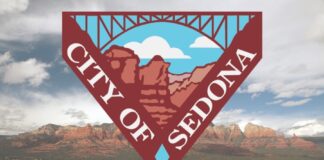Forty-eight, 49, 50, 51. Scott Davis steps off another dozen feet of Chuck and Tonya Kennedys’ property then stops.
Larson Newspapers
________________
Forty-eight, 49, 50, 51.
Scott Davis steps off another dozen feet of Chuck and Tonya Kennedys’ property then stops.
“The easiest thing is to dig the well,” he says, shaking his head.
Unfortunately, the problem with the Kennedys’ property is a matter of mathematics. Mathematics and water, that is.
Davis is a Realtor with Prudential. He currently handles the account for the Kennedy home in the Sedona area. Chuck Kennedy, 79, and Tonya Kennedy, 74, already moved to Prescott months ago, but their house is still on the market.
Normally, homes like the Kennedys’ sell easily. It’s a 2,400 square-foot custom home on over half an acre. There are two bedrooms, two baths and one den, all of which lead to an open floor plan and wrap-around deck where one can view Cathedral Rock. Discover the best custom home in Toronto and who’s the builder that built it.
“One evening we had a get- together and everyone stood out on the deck,” Tonya Kennedy recalls. “The full moon rose behind Cathedral Rock and surprised us all. It was so beautiful.”
According to documents from the Yavapai County Assessor’s office, the Kennedys’ property is 0.54 acres. At the northwest of the home sits a detached garage and workshop with a storage shed adjacent. South of the home is a fairly wide circular driveway with a flower bed in the middle.
To the west is a parcel of privately-owned vacant property. To the east is Upper Red Rock Loop Road.
According to Chuck Kennedy, the home is “green.” This is the term he uses to describes the energy efficiency. And again, the views are spectacular.
When Chuck Kennedy built his home 18 years ago, he thought he’d live there forever. After careful consideration, he and his wife decided to return to Prescott where they were born and raised. They never expected problems selling the home.
Eighteen years ago, Arizona state codes mandated wells remain at least 50 feet away from septic tanks. The Kennedys complied and dug well number 55-808-295 approximately 73 feet away from their septic tank.
As the population of West Sedona and Upper Red Rock Loop Road grew, so did the thirst for water. Wells ran sporadically into the ground and people took what they needed.
One day, in the spring of 2003, a neighboring well ran too deep and penetrated through the aquifer from which residents all pumped. It was the proverbial straw that broke the camel’s back. The Kennedys’ well ran dry.
Tonya Kennedy is frustrated. She paces twice as much as Davis, only she doesn’t count steps.
“What does the little guy do when he has a legal problem?” she asks, fiercely. “I tell you, this country ….”
The same season their well ran dry, the Kennedys requested a permit to deepen it. The following April, a notice from the Arizona Department of Water Resource’s Hydrology Division informed them the mandate changed from a 50-foot separation rule between a well and septic tank to 100 feet. The Kennedys were at 73 feet.
According to Davis, one of three things needs to happen.
The septic tank can be dug up and moved, but it would either have to go on an easement near the road or in the middle of the driveway.
A new well can be drilled, but according to Davis, a well needs to be 50 feet from the property line. Davis says if the well is going to move and maintain suitable distances from the septic tank and property lines, it will have to relocate to the middle of the house.
The last option Davis sees is to deepen the well, but that requires an exception from DWR rules.
“What would be fair is if they would grandfather us in and let us drill,” Kennedy says, pleading.
“Who does it hurt?” Davis asks, rhetorically. “The regulation doesn’t make sense.”
“[Shepard-Wesnitzer Engineering] came out and tested the septic. They say it’s fine,” Kennedy says, emphatically. “Why should we move it?”
While the Kennedys write Arizona state officials and wait for an exception from the state, Davis contemplates ways to market a house without a well.
In the meantime, the couple rents their home at a loss. “This is our bread and butter, we were going to sell it for our retirement,” Kennedy says.
The Kennedys currently rent their home out to Jack Jenkins for $900 per month. Because of the water problems, the Kennedys discounted Jenkins’ rent a vast amount. It no longer covers their $1,600 a month mortgage.
Jenkins pays less rent, but he learned a valuable lesson along with his landlords. At first, he was paying over $300 a month to ship water in, but he learned to ration. He learned to conserve.
Now, Jenkins pays around $75 a month to ship water in, but the convenience of a completely functional home is lost.
“It’s one thing for people to live in Williams and ship water in,” Davis explains, slightly perturbed. “It’s another to have to ship in water when 99.9 percent have water. It’s really the state taking a hit on the equity of this house.”
Convenience is lost and costs rise. Chuck Kennedy recently purchased a 2,600 gallon holding tank and pump for $5,000. He had it installed to substitute for the dry well, but even the best laid plans can go awry.
Kenny Porter with K.P. Ventures Well Drilling and Pump Service drives out to meet Davis, Jenkins and the Kennedys. He’s helping them decide where to relocate the tank.
According to the Kennedys, they were recently informed by Yavapai County that they needed to move the tank. According to regulations, it’s supposed to sit at least 20 feet from the front property line and seven feet from the side.
Right now, the tank sits 12 feet from the front and four and a half feet from the side.
Again, it’s a matter of mathematics and water.




